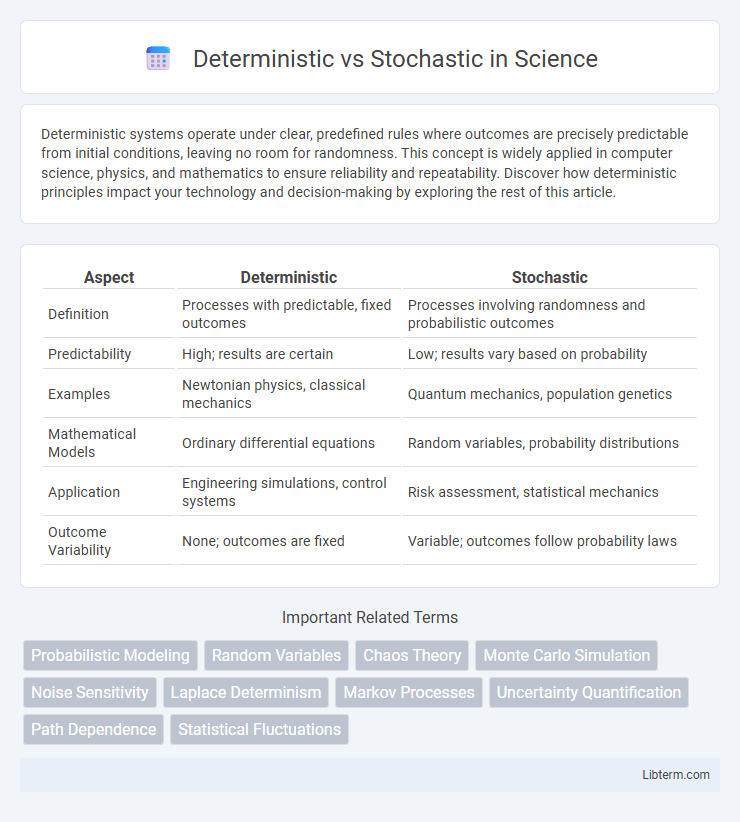Deterministic systems operate under clear, predefined rules where outcomes are precisely predictable from initial conditions, leaving no room for randomness. This concept is widely applied in computer science, physics, and mathematics to ensure reliability and repeatability. Discover how deterministic principles impact your technology and decision-making by exploring the rest of this article.
Table of Comparison
| Aspect | Deterministic | Stochastic |
|---|---|---|
| Definition | Processes with predictable, fixed outcomes | Processes involving randomness and probabilistic outcomes |
| Predictability | High; results are certain | Low; results vary based on probability |
| Examples | Newtonian physics, classical mechanics | Quantum mechanics, population genetics |
| Mathematical Models | Ordinary differential equations | Random variables, probability distributions |
| Application | Engineering simulations, control systems | Risk assessment, statistical mechanics |
| Outcome Variability | None; outcomes are fixed | Variable; outcomes follow probability laws |
Introduction to Deterministic and Stochastic Concepts
Deterministic concepts involve processes where outcomes are precisely determined by initial conditions, ensuring predictability and consistency in results. Stochastic concepts incorporate randomness and probabilistic elements, leading to variability and uncertainty in outcomes despite identical starting points. Understanding the distinction between deterministic and stochastic models is crucial for accurately analyzing systems in fields such as physics, finance, and data science.
Defining Deterministic Systems
Deterministic systems operate under precise laws where identical initial conditions produce consistent and predictable outcomes, leaving no room for randomness. Such systems are characterized by fixed rules or equations that govern their behavior, enabling exact replication and forecasting. Examples include classical mechanics and most traditional computer algorithms, where every state deterministically follows from the previous state.
Understanding Stochastic Processes
Stochastic processes describe systems influenced by random variables, characterized by probability distributions that evolve over time, enabling the modeling of uncertainty in fields like finance and physics. Unlike deterministic processes, where outcomes are precisely determined by initial conditions, stochastic processes incorporate inherent randomness, making their future states probabilistic rather than certain. Common examples include Brownian motion and Markov chains, which are fundamental in predicting asset prices and queueing systems.
Key Differences Between Deterministic and Stochastic Models
Deterministic models produce precise outcomes based on fixed input variables, ensuring the same output with identical initial conditions. Stochastic models incorporate randomness and uncertainty, resulting in variable outcomes even with the same inputs. Key differences include predictability, with deterministic models offering certainty and stochastic models capturing variability reflective of real-world complexities.
Mathematical Foundations of Deterministic Approaches
Deterministic approaches in mathematical modeling rely on fixed, well-defined equations and initial conditions, producing predictable and reproducible outcomes without randomness. These models often utilize differential equations, algebraic expressions, and linear programming to represent systems with precise relationships between variables. By focusing on exact computations and clear cause-effect mechanisms, deterministic methods enable rigorous analysis and optimization in fields such as physics, engineering, and operations research.
Mathematical Framework of Stochastic Methods
Stochastic methods rely on probabilistic models and random variables to capture uncertainty and variability in complex systems, providing a mathematical framework grounded in probability theory and statistics. Unlike deterministic approaches that deliver fixed outcomes from given initial conditions, stochastic frameworks employ concepts such as Markov chains, Monte Carlo simulations, and stochastic differential equations to model dynamic processes with inherent randomness. This mathematical structure enables robust analysis and prediction in fields like finance, physics, and engineering where uncertainty is fundamental.
Real-world Applications of Deterministic Models
Deterministic models are extensively applied in real-world scenarios such as engineering systems, where precise calculations of stress and load ensure structural integrity and safety. In supply chain management, these models optimize inventory levels and delivery schedules to minimize costs and enhance efficiency. Their ability to produce consistent, repeatable outcomes makes them ideal for scenarios requiring exact predictions, such as in aerospace trajectory analysis and electrical circuit design.
Real-world Applications of Stochastic Models
Stochastic models effectively capture uncertainty and variability in real-world applications such as financial market analysis, weather forecasting, and population dynamics. These models use probabilistic approaches to predict outcomes where deterministic models fall short due to inherent randomness. Key examples include Monte Carlo simulations for risk assessment, Markov chains for modeling customer behavior, and stochastic differential equations in epidemiology.
Advantages and Limitations of Each Approach
Deterministic models provide precise and predictable outcomes, enhancing reproducibility and easier validation, but they may oversimplify complex systems by ignoring variability and uncertainty inherent in real-world scenarios. Stochastic models capture randomness and variability, offering more realistic and flexible representations of uncertain processes, though they require more computational power and can produce less interpretable results due to probabilistic nature. Choosing between deterministic and stochastic approaches depends on the problem context, data availability, and the need for accuracy versus simplicity in modeling.
Choosing Between Deterministic and Stochastic Methods
Choosing between deterministic and stochastic methods depends on the nature of the problem and the level of uncertainty involved. Deterministic models provide precise, reproducible outcomes ideal for systems with clear, predictable behavior, while stochastic models capture randomness and variability, making them suitable for complex, real-world scenarios with inherent uncertainty. Evaluating the trade-offs between accuracy, computational cost, and the need to model uncertainty guides the selection process for optimal decision-making.
Deterministic Infographic

 libterm.com
libterm.com